Premade home-style Korean meals are broadening their appeal to people of all ages. Consumers who want to cook also can purchase recipe kits of ingredients that are curated for easy home cooking in perfect amounts.
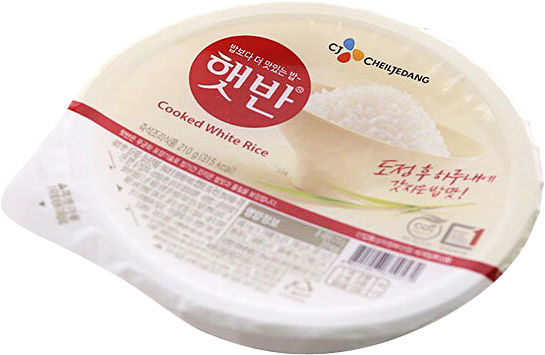
Precooked, microwavable rice, unveiled in 1996, contributed to the launch of the home-style convenience foods market. It was initially shunned by many consumers. But now a variety of brands are steady sellers, and overseas buying is rising. © CJ Cheiljedang
Food delivery flyers are ubiquitous in Korean residential buildings, plastered in lobbies and doorways. Usually, they are nonchalantly tossed in a wastebasket. How many flyers from pizza and fried chicken franchises or traditional Korean restaurants does one household need, anyway? But lately, these flyers have been offering dishes for more adventuresome taste buds.
It’s hard to imagine a household in Korea that has never used prepared foods. The convenience makes them a highly tempting option for singles, couples and families who lack time for grocery shopping and cooking.
According to a survey of 1,000 Koreans aged 19-70 across the country on their dietary habits, conducted by Nielsen Korea’s What’s Next Group in 2018, singles bought premade home-style foods three times a week, and two-or-more-person households bought them twice a week. Euromonitor, another market researcher, says the domestic convenience foods market grew from 1.02 trillion won in 2014 to 1.95 trillion won in 2019. This is expected to more than double to 2.92 trillion won by 2024. The COVID-19 pandemic has probably underscored that estimate; demands for reduced restaurant capacity and social distancing have obviously elevated the profile of meal kits.
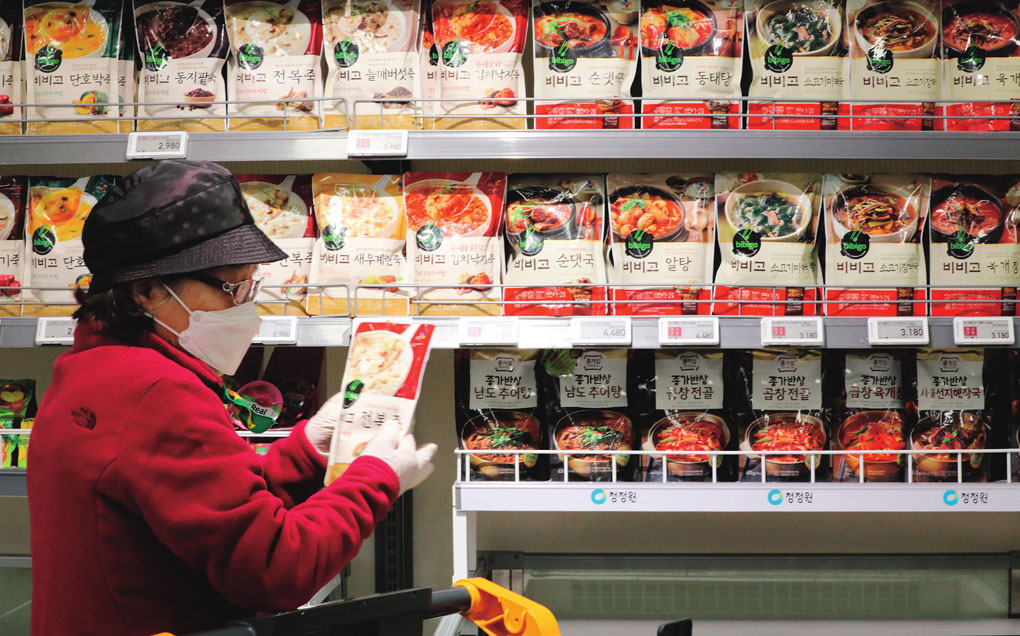
A shopper checks out shelves of home-style convenience foods. Stews, soups and broths are essential parts of the Korean diet, but they require an inordinate amount of time to prepare. RTH (ready-to-heat) foods drastically shorten time in the kitchen. © NewsBank
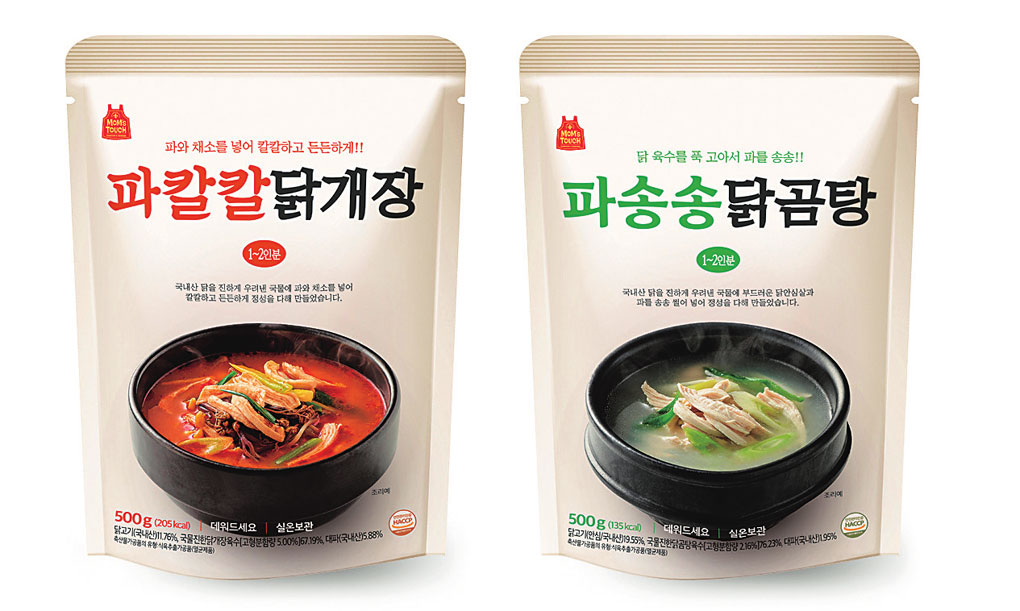
Two types of stews that can be enjoyed in the time it takes to open and heat them up in a microwave oven. © Mom’s Touch
Restaurant-quality meals are now the most popular items in the convenience foods market, especially among food enthusiasts who are unable to visit fine-dining restaurants due to the novel coronavirus pandemic.
Instant Foods
Precooked, microwavable rice blazed the trail. When it was introduced in 1996, it received a cool response from consumers. Rice, of course, is central to Asian diets. Many people had an unwavering belief that the timeworn tradition of daily rice cooking should be kept in the home. There were also incorrect beliefs at the time that instant rice was unhealthy. Despite a marketing campaign featuring celebrity faces, several years passed before instant rice was accepted in people’s daily lives.
These days, food suppliers and supermarkets stock shelves with a wide variety of instant rice brands, realizing that fewer people have an aversion to processed foods than before. In addition, many kinds of processed dishes such as soups, broths, stews and other sides have since been developed, so consumers can prepare substantial meals using only home-style packaged food from the supermarket.
Home delivery of hansik (traditional Korean dishes) accelerated after the introduction of a mobile delivery app in 2010. In recent years, both main dishes and traditional side dishes are offered for delivery. Taken to the extreme, a household could have home-style meals without lifting a knife all week.
There are four basic forms of convenience meals. They are ready-to-eat (RTE) foods, which can be eaten as they are; ready-to-heat (RTH) dishes, which are precooked but must be warmed in a microwave or pot; ready-to-cook (RTC) meal kits of pre-prepared ingredients that must be cooked; and ready-to-prepare (RTP) meal kits, coming with all the necessary ingredients, but left for the consumer to prepare and cook.
Although RTC and RTP kits require more hands-on attention and thus neutralize the time-saving advantage of food delivery, they are gaining popularity with customers who want to feel like they are cooking for themselves. After first appearing in supermarkets, these meal kits have increasingly joined the delivery lineup. In recent years, side dishes have been added to accompany main dishes, sparing even more cooking time.
Haute Cuisine
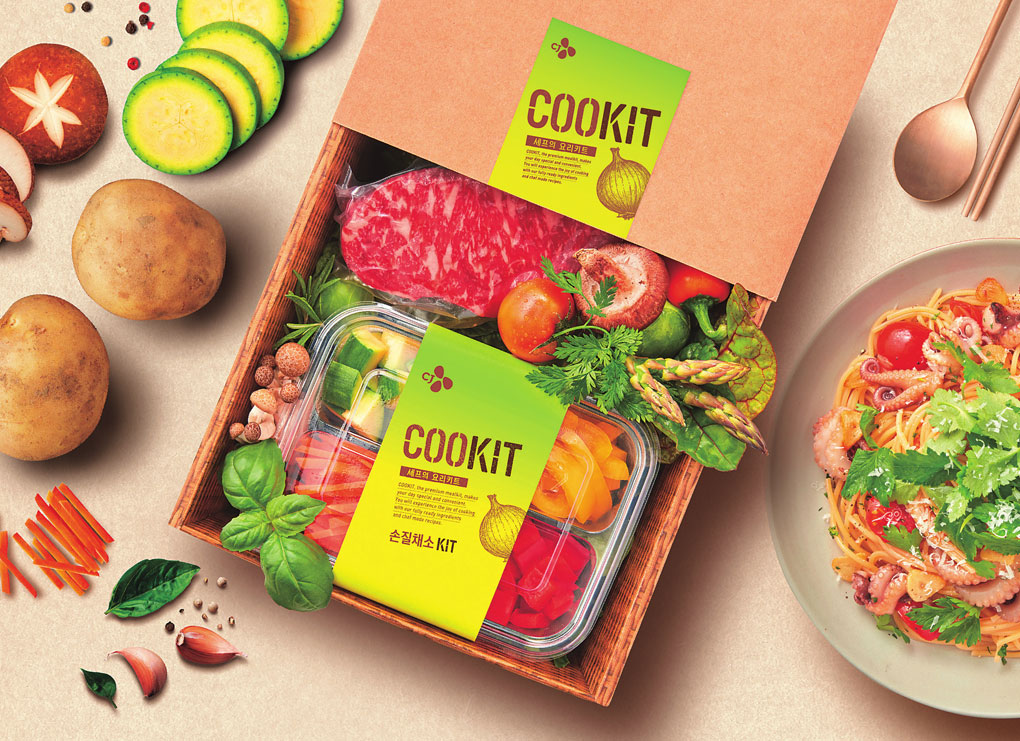
Shoppers who seek the pleasure and satisfaction of cooking can opt for RTP (ready-to-prepare) meal kits. High-end varieties made by veteran chefs are the latest attraction for foodies to enjoy without shopping and slicing and dicing. © CJ Cheiljedang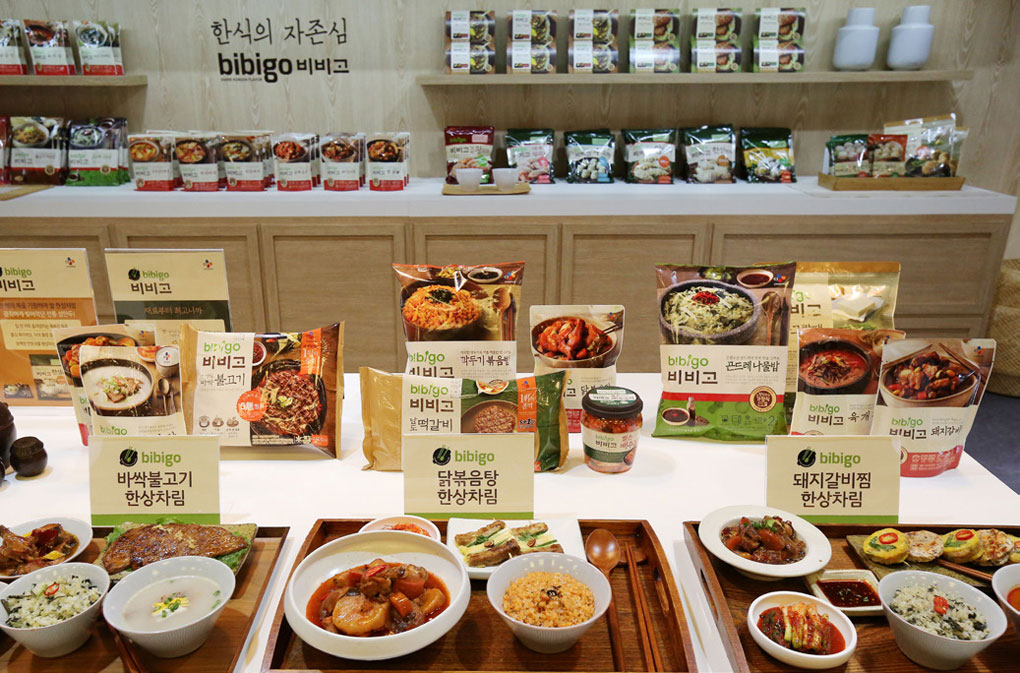
Home-style Korean meal sets are showcased in a promotional event for home meal replacements, held at CJ Injaewon in Seoul in October 2017. Originally targeted at single-person households and working women, precooked convenience foods are attracting more attention from elderly consumers who previously had a negative attitude toward precooked meals. © Yonhap News Agency
Marketing in the convenience foods industry has shifted from an emphasis on convenience and price competitiveness to upscale dining. Restaurant-quality meals are now the most popular items, especially among food enthusiasts who are unable to visit fine-dining restaurants due to the novel coronavirus pandemic.
As a result, convenience cuisine now features “premium” foods. Thirteen veteran chefs who have worked in the kitchens of five-star hotels for more than 10 years are developing meals for CJ Foods, including international dishes like gambas al ajillo (Spanish garlic shrimp, a favorite among young people), pad thai (Thai stir-fried rice noodles) and oyakodon (a Japanese rice bowl dish of chicken and egg). Korea Yakult, a forerunner in the meal kit market, is similarly focused on developing chef-cooked meals consumers can relish at home. They began offering signature dishes from star chefs a few years ago, and recently received an enthusiastic response from consumers for a new mutton dish.
According to Market Kurly, a grocery and home-style meal delivery startup, sales of restaurant-quality meals jumped a staggering 175 percent on-year in the first half of 2020. Market Kurly offers a wide range of products such as galbitang (beef short rib soup), makchang (grilled beef entrails), naengmyeon (cold buckwheat noodles) and ssalguksu (rice noodles) developed by famous restaurant chains across the country.
Millennial Lifestyle
The growth of the convenience meal market is attributed to a surge in the number of single households and dual-income couples, as well as to the prevalence of the millennial lifestyle. One of the important keywords that describe millennials, referring to those born between the 1980s and the early 2000s, and their lifestyle is “efficiency.” They want to cook delicious meals themselves, but dislike time-consuming and cumbersome processes, including shopping and pre-cooking preparations. These competing desires have turned them toward home-style convenience meals, and especially RTC and RTP meal kits that minimize inconvenience but allow them to enjoy cooking to some degree.
The expanding role of homes amid the coronavirus epidemic is another factor behind the boost in the home-style convenience foods market. A new light has been shed on homes as a space for all kinds of activities, such as work, study, hobbies and watching TV and films via home theater systems. Home-style convenience meals are an important alternative in a situation where young people are unable to eat out. Ready-made meal kits provide recipes that help them cook even restaurant-quality foods like sukiyaki, pickled salmon and tuna, and yangjangpi (a mixture of seafood, meat and vegetables in mustard sauce).
In addition to young adults, the elderly and households with children are emerging as influential consumer groups. Perhaps the industry will expand to even wider ranges, including weaning foods for babies and liquid foods for patients. It remains to be seen how far convenience food will evolve “beyond a bite.”